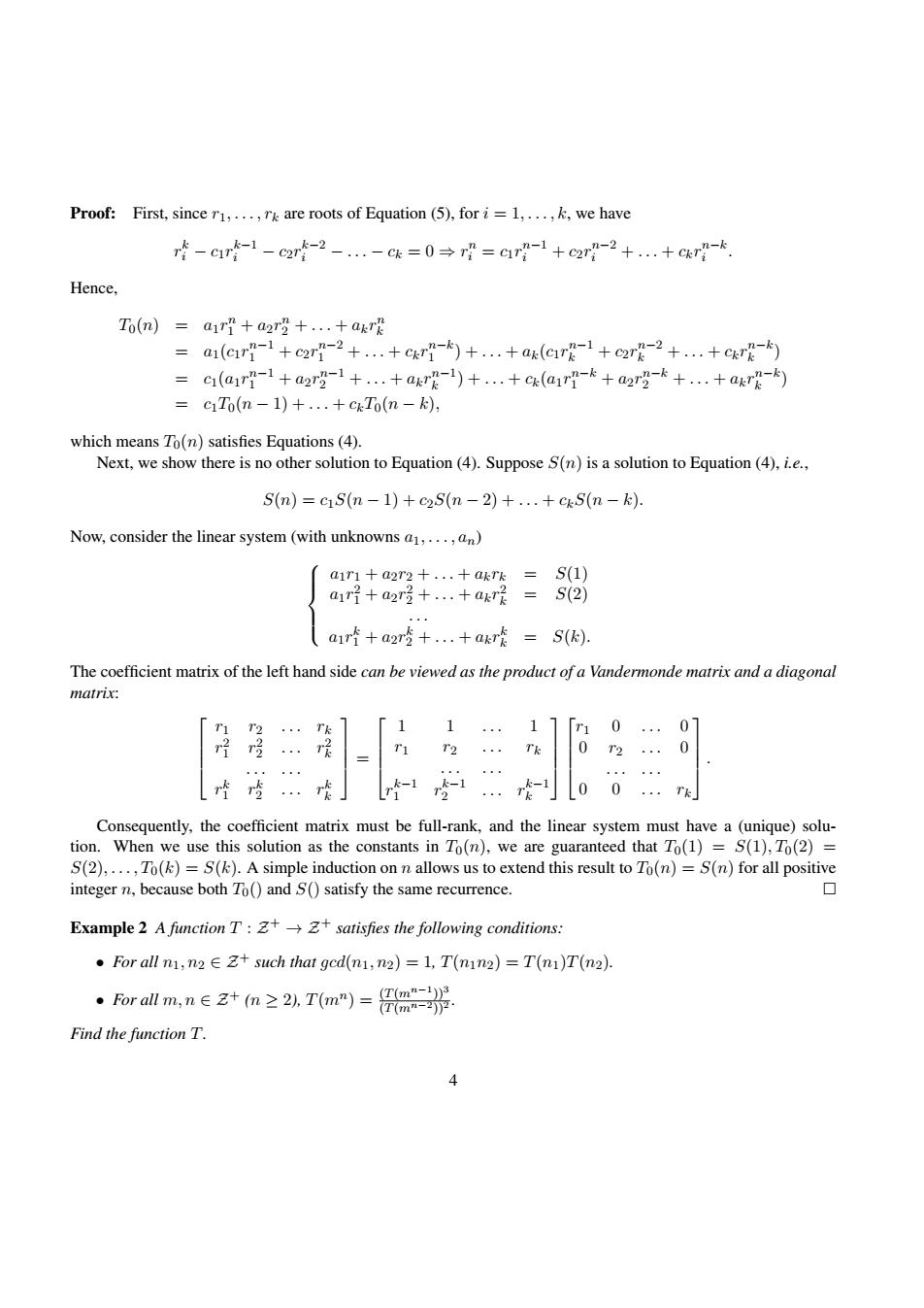正在加载图片...

Proof:First,since r1,...,rk are roots of Equation (5),for i=1,...,k,we have -car-1-c2r-2-.-c以=0→r=r-1+c2r-2+.+ekr-* Hence. To(n)air a2r2+...+akre =a1(Gr1-1+c2r-2+.+cgr-k+.+ak(C1r-1+2r-2+.+cgr-) =G(a1r1-1+a2r2-1+.+ar-1)++c4(a11-k+a2r3-k++ar-k ciTo(n-1)+...+ckTo(n-k), which means To(n)satisfies Equations (4). Next,we show there is no other solution to Equation (4).Suppose S(n)is a solution to Equation(4),i.e., S(n)=cS(m-1)+c2S(n-2)+..+ckS(n-k) Now,consider the linear system (with unknowns a1,...,an) a1r1+a22+..+akTk=S(1) a1r+a2r吃+..+akr2 =S(2) airf +a2r+...+akr S(k). The coefficient matrix of the left hand side can be viewed as the product of a Vandermonde matrix and a diagonal matrix: T2 Tk 0 0 0 0 Tk Consequently,the coefficient matrix must be full-rank,and the linear system must have a(unique)solu- tion.When we use this solution as the constants in To(n),we are guaranteed that To(1)=S(1),To(2)= S(2),...,To(k)=S(k).A simple induction on n allows us to extend this result to To(n)=S(n)for all positive integer n,because both To()and S()satisfy the same recurrence. 口 Example 2 A function T:++satisfies the following conditions: ·For all n1,n2∈Z+such that ged(n1,n2)=1,T(n1n2)=T(m1)T(n2). ·For all m,n∈2+(m≥2,.T(mn)=ma- (T(mn-2庐. Find the function T.Proof: First, since r1, . . . , rk are roots of Equation (5), for i = 1, . . . , k, we have r k i − c1r k−1 i − c2r k−2 i − . . . − ck = 0 ⇒ r n i = c1r n−1 i + c2r n−2 i + . . . + ckr n−k i . Hence, T0(n) = a1r n 1 + a2r n 2 + . . . + akr n k = a1(c1r n−1 1 + c2r n−2 1 + . . . + ckr n−k 1 ) + . . . + ak(c1r n−1 k + c2r n−2 k + . . . + ckr n−k k ) = c1(a1r n−1 1 + a2r n−1 2 + . . . + akr n−1 k ) + . . . + ck(a1r n−k 1 + a2r n−k 2 + . . . + akr n−k k ) = c1T0(n − 1) + . . . + ckT0(n − k), which means T0(n) satisfies Equations (4). Next, we show there is no other solution to Equation (4). Suppose S(n) is a solution to Equation (4), i.e., S(n) = c1S(n − 1) + c2S(n − 2) + . . . + ckS(n − k). Now, consider the linear system (with unknowns a1, . . . , an) a1r1 + a2r2 + . . . + akrk = S(1) a1r 2 1 + a2r 2 2 + . . . + akr 2 k = S(2) . . . a1r k 1 + a2r k 2 + . . . + akr k k = S(k). The coefficient matrix of the left hand side can be viewed as the product of a Vandermonde matrix and a diagonal matrix: r1 r2 . . . rk r 2 1 r 2 2 . . . r2 k . . . . . . r k 1 r k 2 . . . rk k = 1 1 . . . 1 r1 r2 . . . rk . . . . . . r k−1 1 r k−1 2 . . . rk−1 k r1 0 . . . 0 0 r2 . . . 0 . . . . . . 0 0 . . . rk . Consequently, the coefficient matrix must be full-rank, and the linear system must have a (unique) solution. When we use this solution as the constants in T0(n), we are guaranteed that T0(1) = S(1), T0(2) = S(2), . . . , T0(k) = S(k). A simple induction on n allows us to extend this result to T0(n) = S(n) for all positive integer n, because both T0() and S() satisfy the same recurrence. Example 2 A function T : Z + → Z+ satisfies the following conditions: • For all n1, n2 ∈ Z+ such that gcd(n1, n2) = 1, T(n1n2) = T(n1)T(n2). • For all m, n ∈ Z+ (n ≥ 2), T(mn ) = (T(mn−1 ))3 (T(mn−2))2 . Find the function T. 4�